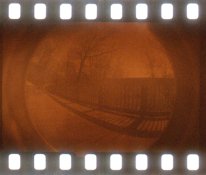DarkroomExperimente
Member
earlier tonight I developed a roll of Tri-X in one of my homemade developers
the basic formula for all my experiments is: (stuff to test) + (sodium carbonate)
so this time it was a developer made from chopped up shallots ( similar to onion, supposed to have a lot of Quercetin ) that soaked in a water/alcohol mix for a week
the developer was 750 ml of the shallot "extract" + 4 tbsp of sodium carbonate ( not all dissolved )
a short strip of Tri-X was developed for 3 hours....when I first looked at the film i thought I have thin negatives with a nice sepia tint....
when I looked again i realized these were POSITIVE images!!!
onions and garlic have allyl propyl disulphide in them ( http://en.wikipedia.org/wiki/Allyl_propyl_disulfide ) ....I wonder is this behaving anything like sodium sulfide which I understand can act as a fogging developer?....could this or something else work on the unexposed silver and leave the latent image alone????
red onion did NOTHING to film when I tried it...so I was expecting the shallot developer to be weak or another total failure
it seems there was no normal development of the images....on the tail of film that was sticking out of the cassette there's the usual dark developed area....but everything else is a lighter brown tone...
what's going on??
I'll post scans tomorrow when the film is dry
the basic formula for all my experiments is: (stuff to test) + (sodium carbonate)
so this time it was a developer made from chopped up shallots ( similar to onion, supposed to have a lot of Quercetin ) that soaked in a water/alcohol mix for a week
the developer was 750 ml of the shallot "extract" + 4 tbsp of sodium carbonate ( not all dissolved )
a short strip of Tri-X was developed for 3 hours....when I first looked at the film i thought I have thin negatives with a nice sepia tint....
when I looked again i realized these were POSITIVE images!!!
onions and garlic have allyl propyl disulphide in them ( http://en.wikipedia.org/wiki/Allyl_propyl_disulfide ) ....I wonder is this behaving anything like sodium sulfide which I understand can act as a fogging developer?....could this or something else work on the unexposed silver and leave the latent image alone????
red onion did NOTHING to film when I tried it...so I was expecting the shallot developer to be weak or another total failure
it seems there was no normal development of the images....on the tail of film that was sticking out of the cassette there's the usual dark developed area....but everything else is a lighter brown tone...
what's going on??
I'll post scans tomorrow when the film is dry




